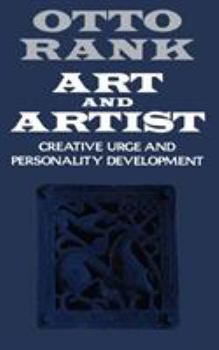Art and Artist: Creative Urge and Personality Development
Select Format
Select Condition 
Book Overview
Along with Adler and Jung, Otto Rank was one of the intellectual giants in the inner circle around Sigmund Freud. Art and Artist, his major statement on the relationship of art to the individual and society, pursues in a broader cultural context Freud's ideas on art and neurosis and has had an important influence on many twentieth-century writers and thinkers, beginning with Henry Miller and Anais Nin.
Art and Artist explores the human urge...
Format:Paperback
Language:English
ISBN:0393305740
ISBN13:9780393305746
Release Date:September 1989
Publisher:W. W. Norton & Company
Length:532 Pages
Weight:0.95 lbs.
Dimensions:1.3" x 4.7" x 8.4"
Customer Reviews
4 ratings
A man ahead his time
Published by Thriftbooks.com User , 16 years ago
Otto rank was one of the most prominent disciples of Freud. His influence permeates important writings of the master like "Totem and taboo", "Moses and the monotheism", for example. When we read Ranks works we are not only penetrating the world of psychoanalysis, we gain insight into anthropology, sociology, psychology and art, in many aspects; this is because Rank had knowledge in all these fields. Besides, he was extremely intelligent, so much so that Freud decides to finance his studies. In Art and artist we should see some of his ideas and realized why he went apart from the master, overcoming him in many aspects, as Ranks's opinions about humankind conflicts were beyond the psychoanalysis realm.
that angry?
Published by Thriftbooks.com User , 16 years ago
i don't get how 2 people can have 5 star reviews and one so much lower, it seems more like an anger at the rating system "bringing the ratings down", just silly really, who are we to try to review writings this far past being written. our minds are so full of pop culture oatmeal it's a wonder we don't sit around drooling all day staring at walls. long live the works of otto rank.
A Cultural Problem
Published by Thriftbooks.com User , 24 years ago
For anyone who is interested in "Beauty and Truth" as a problem requiring intense evaluation, Chapter Eleven of this book starts by considering the conquest of nature "really her successful deception by the human intelligence." The interesting feature is "the pleasure which the individual gets from this sham activity, in that we regard this as a saving of vitality and, indeed, of life." Otto Rank associated this kind of activity with "the realm of freedom ~ even if (again as in play) this liberation can never be wholly successful." As an ideal, art can lead to a way of life which approaches the pathetic in finding pleasures in pushing the envelope which maintains order for the prone thinkers in any society. Rank considered it a component of "head-culture, . . . saturated with the scientific ideology" associated with "the egocentric outlook which produced the competitiveness and quarrelsomeness of the various Greek tribes, cities, and heroes that is evidenced even in the Trojan War stories." My knowledge of the history of American psychiatry clings to the memory of the minor role played by Harry Stack Sullivan in establishing the professional ethics that kept Otto Rank from treating his patients as a psychiatrist because he wasn't a doctor. While some memory of artistic character development clings to people's emotional problems, medical practice in the mental health field makes this book almost irrelevant to modern treatment of these problems, and I only mention it to show what fools we would prefer to be as a society dedicated to the suppression of all uncommercial efforts in the area of art, which remains a highly suspect activity, subject to ritual condemnations by the critics in the press who can't print what the artist is thinking. For people who don't expect to read this book, I would recommend the movie "I Shot Andy Warhol" as a study in character of the wanna-be kind of people which a culture that celebrates art and drama produces.
Rank's masterpiece, the culmination of his cultural analysis
Published by Thriftbooks.com User , 26 years ago
Beginning with a monograph in 1907 that first brought him to Freud's attention, Otto Rank became his mentor's closest colleague until 1926. The present work, published in 1932, follows three earlier elaborations of the first monograph, and covers artistic endeavor, language, play, architecture, etc. through the ages as an expression of a striving for individual/communal immortality and a reconciliation with mortality. The creative type lives life, affirming the inevitable, while the neurotic is frozen with life-fear. A fine translation reads well but Ludwig Lewisohn's terrific preface has been replaced here with one by the lighter-weight but better-known Anais Nin. The book rewards study; see an excerpt on the Otto Rank Website.






